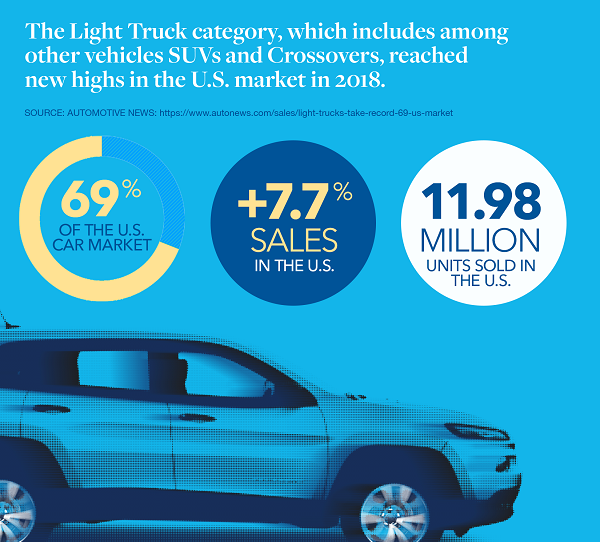Cars Aren’t Dead: They’re Just Morphing into What Comes Next
By Keith Spacapan
Much has been written about the so-called “death of the car” as of late. With Ford and other major Original Equipment Manufacturers (OEMs) announcing and demonstrating dramatic decreases in production of their once-flagship 2-and 4-door models in favor of SUV, crossover and pickup truck line-ups, the handwriting appears to be on the wall for a future of highways sparsely traveled by once-revered coupes and sedans.
But do we really think that given the speed of technological innovation and the “Internet of things” now upon us, that the current vehicle darling of the industry -the SUV as it exists today- can be far behind our once-coveted cars in its march toward obsolescence?
SUVs are the fastest growing category of vehicle on the road today. Their complex drive-trains and suspensions well surpass a typical sedan’s part count and cost. Their next generation cousin, the crossover, has been growing rapidly in U.S. unit sales year over year. Yet, many in the industry believe that even these immensely popular and seemingly innovative vehicles are likely to run their course as well over the next decade.
If, indeed, the traditional car as we have known it is “dead”, and its current successors are likely to be short-lived placeholders for what is to come… to understand what’s next and how it will impact the asset-based valuations we perform in the automotive industry, it is necessary to first understand how we got here.
From Horseless Carriages to Push-Button Radios and Wireless Bluetooth
Long before the Industrial Revolution and the combustion engine’s placement into the steel behemoth known as the Model T, horses and horse-drawn carriages set the tone for moving from one place to another more quickly than was possible on foot. In those early days, transporting people was a basic necessity, and the vehicle for doing so started out frills-free and basic by design. However, as the trade of transporting people evolved into the burgeoning industry of transportation, market demand and the quest for market dominance ushered in a movement beyond basic transport and into the realm of passenger then driver preference, comfort and convenience.
The golden days of the automobile in the 1940s, 50s and 60s were characterized by a focus on crafting tantalizing exterior design elements; undulating lines and curves that elicited emotion, building preference for and distinguished automakers’ brands.
For those of us old enough to remember the sparse interiors of cars with front bench seats, manual crank windows, no air conditioning and rarely used seatbelts, it’s safe to say that the concept of “tech” in transport wasn’t even a glimmer in the industry’s eye back in the 60s and early 70s. To put it into perspective, the ability to pre-set stations on a radio and determine how fast your wipers moved across your windshield were truly revolutionary for the time.
By the 90s and into the early 2000s, the standardization of parts across an OEM’s brand and product line drove down costs, but also, to a great degree, ushered in an end to an era of true uniqueness between automobiles. At first, those with a keen eye began to notice commonalities in parts such as switches, door handles, speedometers, mirrors and trim panels among OEMs’ offerings. As time passed, those commonalities became much more apparent and pervasive. Today, these shared components help drive many of the efficiencies achieved throughout OEMs’ global platforms. Innovations over the years stemming from EPA and other regulatory requirements have included more fuel-efficient engines, antilock braking systems, front and side curtain airbags and backup cameras. These camera systems, for the most part, required dashboard-mounted screens with certain resolution capabilities. Having previously equipped many vehicles with navigation screen functionality, the next step to higher resolution in support of live images was relatively easy. Coupled with the development of Bluetooth technology and mobile phone integration into vehicles, the stage was set for a cascade of rapid technological advancement.

SO, WHAT’S NEXT?
The Tablet and Battery Effect
Tesla, at long last, recently announced that its affordable $40,000ish SUV is coming soon to an online showroom near you and that you can purchase it in under five minutes on your mobile device. This so-called “everyman’s Tesla” is perhaps our first true glance at what the future may hold for the SUV and its offspring in the post-car era. Gone are the stand-alone analog and digital clusters, screens, gauges, relays and related wiring. In its place… the simplicity of a single interface that can be efficiently removed, replaced and reconditioned for future use. With its self-contained, iPad-like touchscreen serving as everything from speedometer to infotainment system, we can begin to see how the current industry supply chain model may be altered and how the need for inventoried OEM and aftermarket replacement parts and pricing may be impacted.

Similarly, we can envision how the regular maintenance of gaskets, seals, sensors and fluids related to traditional combustion engines may likely become a thing of the past as electric vehicle batteries continue to evolve and OEMs implement battery change-out plans as part of ongoing maintenance contracts. Simply drive into your local battery swap bay of the very near future and your old battery will unclip and slide out while its replacement glides in and locks into place, all on an automated platform, within a matter of a few minutes. If you question that reality, you might be surprised to learn it’s already happening today in China, where over 200 companies are producing electric cars in an incubator-type industry environment highly subsidized by the government. In the U.S. and around the globe, faced with increasing expectations for ever more stringent fuel economy, cleaner emissions and other looming regulatory deadlines, OEMs are committing billions of dollars in the race toward electric vehicle competency in the short term and a foothold into practical autonomous vehicles in the longer term.
We Are Ankle-Deep in the Future Now
So, what are we to make of the direction of the automobile industry? Why it’s headed where it’s headed and what it will mean for OEMs, the price of OEM and aftermarket parts, electronic componentry and manufacturing equipment? How it’s likely to affect dealer inventories, incentives, finances and the cost of fuel for drivers on the road?
While we at Hilco Valuation Services are most definitely not in the business of predicting the future or future markets, we do believe that it’s good business for us as valuation professionals, as well as for our customers, to keep our eyes and ears open to anticipate and prepare for what is likely to come next.
That said, it seems the time may have come to rethink what an automobile is vs. what it has been. Historically, an automobile has been a mass of steel and plastic hardware, suspended above a fuel tank, resting on four rubber tubes and propelled by an engine with hundreds of moving and component parts. But all that is changing rapidly.
In fact, it may now be time to think about an automobile more as equal parts hardware and software/user experience. While I can’t take credit for this astute perspective, which was put forth by a prominent futurist, I do believe that it is likely a sound observation of where the automotive industry is heading… toward producing an autonomous mobility experience that you sit inside of, and engage with, while being moved from one place to another.
Delivering Highly Accurate Valuation In a Rapidly Changing Environment
It is logical to assume that the pace at which the Automotive environment is advancing beyond a hardware-based model reliant upon thousands of component parts, into a more unified software and experiential space, will have a marked impact on the effective lifespan and depreciation of the components, chips, displays and operating systems used in vehicles.
From a valuation practitioner perspective, this has the potential to present certain challenges to organizations without well-documented, organized historical trend data or the industry knowledge and thought leadership needed to prepare for what comes next.
Hilco Global has the smarts to navigate the road ahead


.jpg?sfvrsn=f1093d2a_0)